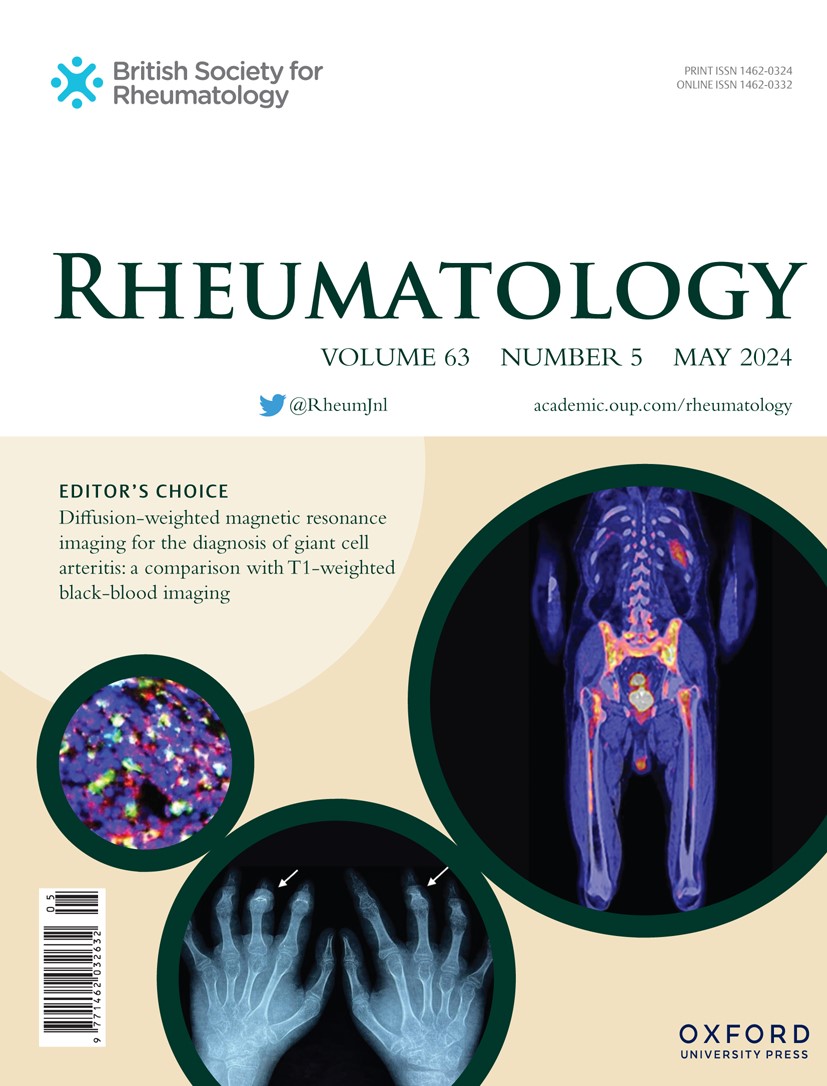轴型银屑病关节炎患者不符合ASAS轴型脊柱炎分类标准的背痛进入特征:来自attraction研究的发现。
IF 4.7
2区 医学
Q1 RHEUMATOLOGY
引用次数: 0
摘要
目的应用ASAS的axSpA分类标准对axSpA进行分类是一个有争议的话题。在这项研究中,我们旨在确定不符合ASAS分类标准的进入性疼痛特征的银屑病和背痛患者中axPsA的患病率。方法在DCS筛查工具中报告迟发性背痛(LoBP, 45岁以后)或非慢性背痛(NcBP,持续时间少于几个月)的患者被纳入“非asas背痛”(Non-ASAS /BP)组。他们接受了针对axPsA诊断的临床/仪器评估,并比较了在筛查时满足两种ASAS进入性疼痛特征(ASAS/BP)的患者。结果经风湿学评估,50/265(18.8%)例患者、34/50(68%)例LoBP和16/50(32%)例NcBP归为非asas /BP组。与ASAS/BP患者相比,平均年龄更高,IBP患病率更低。两组患者的临床疾病活动度相似。AxPsA在6/50(12%)非ASAS/BP患者中得到证实,低于ASAS/BP组(29.0%)。最后,非ASAS/BP axPsA患者表现出与ASAS/BP axPsA患者相似的炎症和炎症后x线片和/或MRI改变比例。结论本研究表明,在经历迟发性或非慢性背痛的银屑病患者中,有相当比例的患者可能受到活性axPsA的影响,从而不满足ASAS进入疼痛特征。本文章由计算机程序翻译,如有差异,请以英文原文为准。
Axial psoriatic arthritis in patients not fulfilling the back pain entry features of the ASAS Classification Criteria for Axial Spondyloarthritis: findings from the ATTRACT Study.
OBJECTIVE
Application of the ASAS classification criteria for axSpA in classifying axPsA is a topic of debate. In this study, we aimed to determine the prevalence of axPsA in patients with psoriasis and back pain who do not meet the entry pain features of the ASAS classification criteria.
METHODS
Patients reporting late-onset back pain (LoBP, after the age of 45) or non-chronic back pain (NcBP, lasting less than months) in the DCS screening tool were included in a group coined "Non-ASAS Back Pain" (non-ASAS/BP). They underwent clinical/instrumental assessment aimed at axPsA diagnosis and were compared with those patients fulfilling both two ASAS entry pain features at the screening (ASAS/BP).
RESULTS
After rheumatologic evaluation, 50/265 (18.8%) patients, 34/50 (68%) LoBP and 16/50 (32%) NcBP, were categorised as non-ASAS/BP group. In comparison with ASAS/BP patients, the mean age was higher, and the prevalence of IBP was lower. Clinical disease activity was similar between the two groups. AxPsA was confirmed in 6/50 (12%) non-ASAS/BP patients, which is a lower incidence than in the ASAS/BP group (29.0%). Finally, non-ASAS/BP axPsA patients showed a similar proportion of inflammatory and post-inflammatory radiographic and/or MRI changes as shown in ASAS/BP axPsA patients.
CONCLUSION
This study demonstrates that among psoriatic patients who experience late-onset or non-chronic back pain, thereby not fulfilling ASAS entry pain features, a considerable proportion may be affected by active axPsA.
求助全文
通过发布文献求助,成功后即可免费获取论文全文。
去求助
来源期刊

Rheumatology
医学-风湿病学
CiteScore
9.40
自引率
7.30%
发文量
1091
审稿时长
2 months
期刊介绍:
Rheumatology strives to support research and discovery by publishing the highest quality original scientific papers with a focus on basic, clinical and translational research. The journal’s subject areas cover a wide range of paediatric and adult rheumatological conditions from an international perspective. It is an official journal of the British Society for Rheumatology, published by Oxford University Press.
Rheumatology publishes original articles, reviews, editorials, guidelines, concise reports, meta-analyses, original case reports, clinical vignettes, letters and matters arising from published material. The journal takes pride in serving the global rheumatology community, with a focus on high societal impact in the form of podcasts, videos and extended social media presence, and utilizing metrics such as Altmetric. Keep up to date by following the journal on Twitter @RheumJnl.
 求助内容:
求助内容: 应助结果提醒方式:
应助结果提醒方式:


